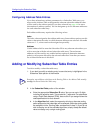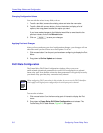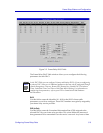
Frame Relay Status and Configuration
5-6 Configuring Frame Relay Ports
¥ For the FRX6000, ports 0-7 on each RLP are determined by the Line Interface
Card (LIC) and attached I/O cables. Only the valid interfaces will be listed
from the menu button. Possible interfaces are: RS-232, V.35, RS-449, RS-530 and
X.21. (RS-449, RS-530, and X.21 interfaces require an RS-422 LIC.)
Blocked Flag
This value will cause the port to be enabled (if No) or disabled (if Yes) when the
device is powered up or re-booted.Whichever state is selected, the port will
remain in that state until this value is changed or until an enable or disable action
is performed.
Logical DCE
This parameter deÞnes the portÕs role as logical DCE (if Yes) or logical DTE (if
No). The port conÞgured as the DTE serves as the user-side equipment, sending
data to an interface device (DCE, or network-side equipment) for encapsulation in
a frame relay frame and transmission onto the frame relay network. The DTE also
receives de-encapsulated data from the DCE for transmission onto its local
network. Each port must be conÞgured for the opposite value of that conÞgured
for its link partner Ñ that is, a logical DCE must be connected to a logical DTE,
and vice versa.
Generate Clock
This setting speciÞes whether the port will generate the clock, or timing,
necessary to synchronize trafÞc over the link. If the port is a physical DCE (as
determined by the portÕs I/O cable interface), specify Yes, since the physical DCE
generates clock. If the port is a physical DTE, specify No.
Receive Clock from DTE
If this parameter is set to Yes, it allows the clock (timing) signal to be looped back
from the DTE using the Terminal Timing (TT) signal, which can be helpful on
high-speed lines. Generally, if the local interface is a physical DCE and the line
speed is above 256 Kbps, this parameter should be set to Yes; however, make sure
the DTE is conÞgured to provide the terminal timing.
Link Layer Management
When Link Layer Management is active, the protocol in use will verify and
maintain the integrity of the link. The setting of this value determines whether
link status enquiries will be used, and what form they will take:
no LMI No Local Management Interface (LMI). No status
enquiries will be used; this setting essentially disables
frame relayÕs management abilities. LMI will prevent any
NOTE
Note that logical and physical DCE and DTE settings are independent of one another; a
port can be both a logical DTE and a physical DCE.


















